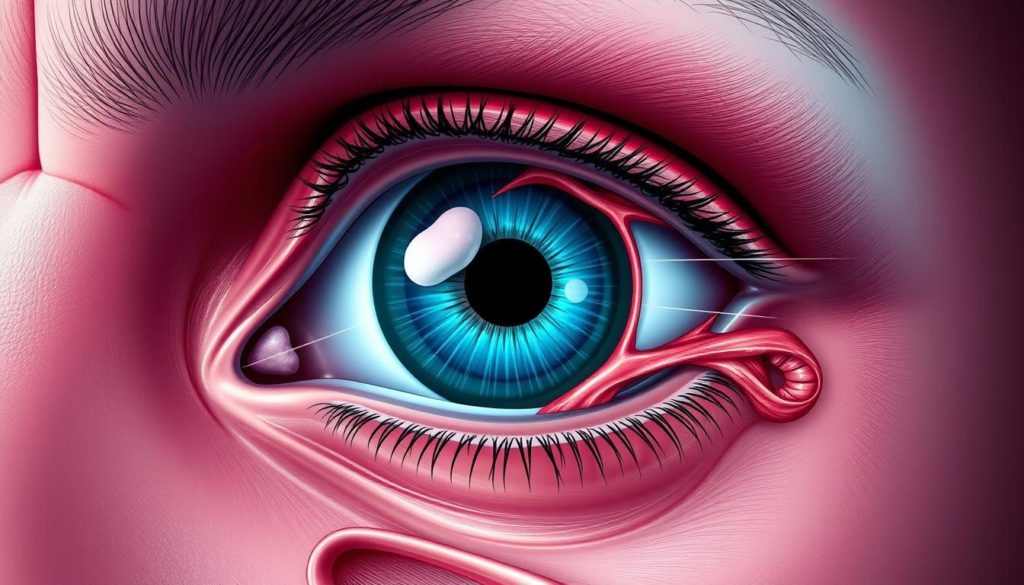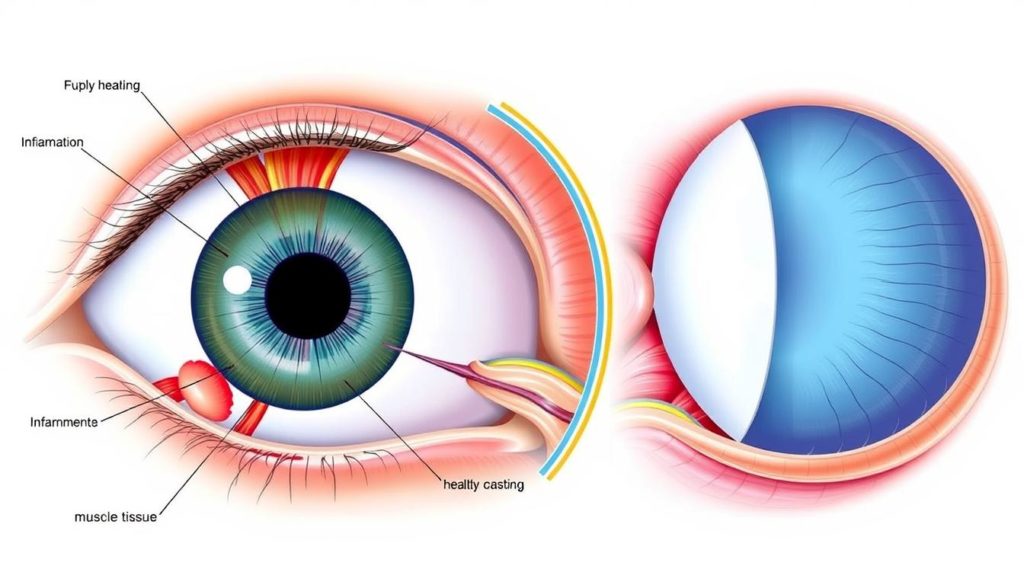“Health is a state of complete physical, mental, and social well-being and not merely the absence of disease or infirmity.” – World Health Organization
Thyroid Eye Disease (TED) is more than a medical issue; it’s a life-changing journey. It impacts many areas of life. This guide offers key insights to help you understand TED better.
By learning about Thyroid Eye Disease, you can better manage its effects. This knowledge is crucial for dealing with its health outcomes.
What Is Thyroid Eye Disease?
Thyroid Eye Disease, or TED, is an autoimmune condition. It’s closely tied to thyroid issues, like hyperthyroidism or Graves’ disease. But, it can also happen in people with normal or underactive thyroid levels. Knowing about Thyroid Eye Disease is important for grasping its complexities.

Overview of Thyroid Eye Disease
Thyroid Eye Disease (TED) causes inflammation and swelling in the eye orbit. This can lead to symptoms like bulging eyes, discomfort, and vision issues. A detailed look at TED shows how it affects people differently, with varied symptoms and progressions.
Common Misconceptions
There are many myths about Thyroid Eye Disease. One big one is that it only affects those with an overactive thyroid. But, TED can also hit people without hyperthyroidism. Clearing up these myths helps patients understand their condition better and get the right care.
Thyroid Eye Disease Overview
Thyroid Eye Disease (TED) is an autoimmune disorder that affects the tissues around the eyes. It causes inflammation, swelling, and other complications. Knowing its medical definition, prevalence, and who is at risk is key to managing it well.
Medical Definition
Medically, Thyroid Eye Disease is an orbitopathy caused by autoimmune disturbances. It changes the connective tissue and muscles around the eyes. Symptoms include bulging eyes, dry eyes, and double vision.
Statistics and Prevalence
The prevalence of Thyroid Eye Disease is higher in people with thyroid disorders. About 25-50% of those with Graves’ disease, a common cause of hyperthyroidism, get TED. Smoking also raises the risk of getting this disease. Women are more likely to get TED than men, and it often affects middle-aged individuals.

Who Is at Risk?
People with thyroid disorders, smokers, and women are at higher risk for TED. Middle-aged individuals are also more likely to be affected. Early detection is crucial to prevent severe complications and manage the disease effectively.
Causes of Thyroid Eye Disease
Understanding Thyroid Eye Disease (TED) is key to managing and preventing it. The causes include genetic and environmental factors, and the autoimmune response in TED.
Genetic Factors
Genetics play a big role in TED. Certain genes make some people more likely to get it. Family history is important in understanding TED etiology.
Environmental Triggers
Environmental factors also matter a lot. Smoking is a big risk factor for TED. Stress and chemicals can also play a part.
Autoimmune Response
The autoimmune response is central to TED. The immune system attacks the eye tissues, causing inflammation. Researchers are working to understand this immune reaction better.
| Causes | Description |
|---|---|
| Genetic Factors | Family history and specific genes linked to increased risk |
| Environmental Triggers | Factors like smoking and chemical exposure |
| Autoimmune Response | Immune system attacking orbital tissues |
Symptoms of Thyroid Eye Disease
It’s important to spot Thyroid Eye Disease early. This helps in getting the right treatment. Here, we list common and severe symptoms to know when to see a doctor.
Common Symptoms
Some TED symptoms are mild but still important to notice. These include:
- Dryness
- Eye grittiness
- Redness
- Mild swelling
Severe Symptoms
Ignoring mild symptoms can lead to worse ones. Look out for:
- Significant swelling
- Intense redness
- Protruding eyes (proptosis)
- Vision loss
When to See a Doctor
See a doctor if you have severe symptoms or if mild ones get worse. Early treatment can stop serious problems. Don’t wait to get medical help to avoid Thyroid Eye Disease risks.
Diagnosis of Thyroid Eye Disease
Finding out if you have Thyroid Eye Disease (TED) takes a few steps. First, you get checked and then more tests follow. These steps are key to making sure you get the right diagnosis.
Initial Assessment
Your journey starts with a visit to a specialist, like an endocrinologist or ophthalmologist. They will look at your medical history and do a physical exam. This is important to prepare for the next steps.
Diagnostic Tests
Next, you’ll have tests to learn more about your condition. These include:
- Blood tests to check your thyroid hormone levels.
- Imaging tests like CT scans, MRIs, or ultrasound of the orbits.
These tests help see how bad the thyroid eye condition is. Blood tests check your thyroid, and imaging tests show the eye area in detail.
Confirmatory Diagnosis
To confirm TED, doctors look at your symptoms and test results. They compare what they find to make sure you have TED. This careful process helps plan the right treatment for you.
Treatment for Thyroid Eye Disease
Treatments for Thyroid Eye Disease (TED) aim to manage symptoms and control the immune system. Patients have different options based on their condition’s severity and progression.
Medications
Medications are often the first choice for Treating TED. Corticosteroids are used to reduce inflammation. Immunotherapy is another option to control the immune system’s response. It’s important for patients to follow their doctor’s advice while taking these medications.
Surgical Options
In advanced cases, surgery might be needed. Procedures like orbital decompression can help with symptoms like eye bulging. These surgeries are considered when there’s a risk to vision or severe pain.
Alternative Treatments
Some people try alternative treatments for TED symptoms. These include acupuncture, herbal supplements, and lifestyle changes. But, it’s important to talk to a healthcare provider about the safety and effectiveness of these options.
| Treatment Options | Advantages | Considerations |
|---|---|---|
| Medications | Non-invasive, quickly reduce inflammation | Potential side effects, requires ongoing monitoring |
| Surgical Options | Effective for severe cases, can restore normal eye appearance | Invasive, potential surgical risks |
| Alternative Treatments | Natural, low-risk | Varied efficacy, need medical consultation |
Complications of Thyroid Eye Disease
Thyroid Eye Disease (TED) is more than just a cosmetic issue. If not treated, it can cause serious problems. These issues can affect a person’s daily life and overall health. It’s important to understand these risks to manage the disease effectively.
Vision Impairment
One major complication of TED is vision problems. This can happen due to the eyes not getting enough moisture or because of pressure on the optic nerve. If not treated quickly, it can lead to permanent vision loss.
Patients might see double or have blurry vision. These issues can make everyday tasks very hard.
Quality of Life Issues
The effects of Thyroid Eye Disease go beyond vision. It can also affect how a person feels about themselves and their social life. Many patients feel embarrassed or anxious because of their appearance.
This can really hurt their mental health and how they interact with others.
Long-term Health Risks
Long-term, TED can lead to ongoing eye problems and a higher chance of other autoimmune diseases. The constant inflammation and need to manage symptoms can also cause more health issues. These may need medical treatment.
| Complication | Impact | Management |
|---|---|---|
| Vision Impairment | Double vision, reduced acuity | Medical or surgical treatment |
| Quality of Life | Self-consciousness, anxiety | Support groups, counseling |
| Long-term Risks | Chronic inflammation, other autoimmune diseases | Regular monitoring, medication |
Management of Thyroid Eye Disease
Managing Thyroid Eye Disease (TED) requires a comprehensive approach. It involves many aspects of the condition. With the right strategies, living with TED can improve your quality of life.
Lifestyle Changes
Changing your lifestyle is key to managing TED. Quitting smoking is crucial as it can worsen symptoms. Eating foods rich in antioxidants, like berries and nuts, also helps.
Regular Monitoring
Regular check-ups are vital for tracking the disease. They help catch any changes early. This ensures your treatment plan stays effective.
Support Groups and Resources
Support groups and resources are essential for managing TED. They offer emotional support and practical advice. Educational materials and counseling services provide valuable information to help you cope.
Finding a Thyroid Eye Disease Specialist
Getting an appointment with a Thyroid Eye Disease expert is key for the best care. These doctors, often oculoplastic surgeons or orbital specialists, know how to handle TED well. They offer advanced treatments and plans made just for you.
When looking for a TED specialist, check their credentials and experience. Choose doctors who are board-certified and have a lot of experience with TED. Many top medical centers in the U.S. have TED clinics with leading experts. It’s a good idea to talk to them about your situation and see if they’re a good fit.
Also, don’t forget to look at what other patients say. Reading reviews from people with TED can help you decide. Getting care from a dedicated TED doctor means you get the latest treatments and the care you need to live well.
FAQ
What is Thyroid Eye Disease (TED)?
Thyroid Eye Disease, or TED, is an autoimmune condition. It makes the eye muscles and fatty tissue behind the eye swell. It can happen with or without thyroid problems.
What are the common symptoms of Thyroid Eye Disease?
Symptoms include dry, gritty, red, swollen, and bulging eyes. Severe cases can cause vision loss. Seeing a doctor quickly is important.
How is Thyroid Eye Disease diagnosed?
A specialist like an endocrinologist or ophthalmologist does the first check. Blood tests and imaging like CT scans or MRIs are used to diagnose.
What causes Thyroid Eye Disease?
TED’s cause is complex. It involves genetics and environmental factors like smoking. An autoimmune attack on eye tissues also plays a big role.
What treatment options are available for TED?
Treatments aim to reduce swelling and manage symptoms. Steroids and immunotherapy are common. Surgery is an option for severe cases. Always talk to a doctor about treatments.
Who is at risk of developing Thyroid Eye Disease?
People with thyroid issues, especially women and middle-aged adults, are at risk. Smoking greatly increases the risk. Making lifestyle changes helps manage the disease.
What complications can arise from untreated Thyroid Eye Disease?
Untreated TED can cause vision problems. This can also affect a person’s quality of life, leading to stress and discomfort.
How is Thyroid Eye Disease managed on a daily basis?
Managing TED involves lifestyle changes like quitting smoking and eating antioxidant-rich foods. Regular check-ups and using resources can help cope with the disease.
How can I find a specialist for Thyroid Eye Disease?
Finding a specialist like an oculoplastic surgeon is key for care. They offer advanced treatments and create personalized plans for managing TED.


